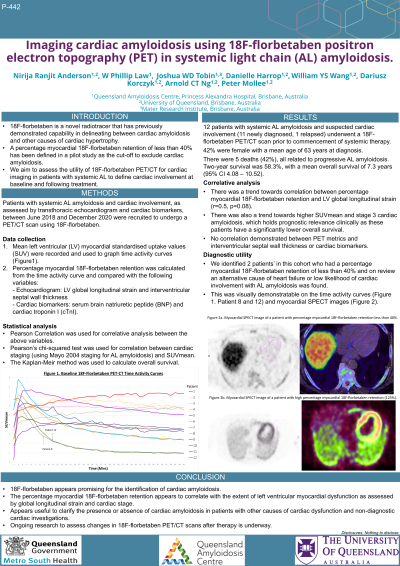Other plasma cell disorders
Poster Session 3
P-442: Imaging Cardiac Amyloidosis using 18F-Florbetaben Positron Electron Topography (PET) in Systemic Light Chain (AL) Amyloidosis.
Friday, September 29, 2023
1:15 PM - 2:15 PM EEST


Nirija Ranjit Anderson, MBBS
Clinical Haematology Fellow
Princess Alexandra Hospital, Queensland Health
Brisbane, Queensland, Australia
Introduction: 18F-florbetaben is a novel radiotracer that has previously demonstrated capability in delineating between cardiac amyloidosis and other causes of cardiac hypertrophy.
We aim to assess the utility of 18F-florbetaben PET for cardiac imaging in patients with systemic AL to define cardiac involvement at baseline and following treatment.
Methods: Newly diagnosed or relapsed patients with systemic AL amyloidosis and cardiac involvement, as determined by 2D speckled transthoracic echocardiogram and cardiac biomarkers, between June 2018 and December 2020 were approached to undertake a PET scan using 18F-florbetaben.
Mean and maximal left ventricular (LV) myocardial standardised uptake values (SUV) were recorded and used to graph time activity curves (TAC). Percentage myocardial 18F-florbetaben retention was calculated from the TAC and compared with the following variables: LV global longitudinal strain (GLS) and intraventricular septal wall thickness (IVs); serum brain natriuretic peptide (BNP) and cardiac troponin I (cTnI), using Pearson Correlation for statistical analysis. Pearson’s chi-squared test was used for correlation between cardiac staging (using Mayo 2004 staging for AL amyloidosis) and SUV. The Kaplan-Meir method was used to calculate overall survival.
Results: 12 patients with systemic AL amyloidosis and suspected cardiac involvement (11 newly diagnosed, 1 relapsed) underwent a 18F-florbetaben PET scan prior to commencement of systemic therapy; 42% were female with a mean age of 63 years at diagnosis. There were 5 deaths (42%), all related to progressive AL amyloidosis. Two-year survival was 58.3%, with a mean overall survival of 7.3 years (95% CI 4.08 – 10.52).
Statistical significance was not reached but there was a trend towards correlation between percentage myocardial 18F-florbetaben retention and LV GLS (r=0.5, p=0.08). There was no correlation demonstrated between IVs, BNP or cTnI in this study. There was also a trend towards higher SUVmean with stage 3 cardiac amyloidosis, which holds prognostic relevance clinically as these patients have a significantly lower overall survival.
Of note, a previously defined cut-off in a pilot study using a percentage myocardial 18F-florbetaben retention of less than 40% to exclude cardiac amyloidosis did prompt review of 2 patients’ cases in this cohort and findings supported either an alternative cause of heart failure or low likelihood of cardiac involvement with AL amyloidosis (IgM type, with normal cardiac biomarkers and borderline echocardiogram findings).
Conclusions: The utility of 18F-florbetaben PET in AL amyloidosis is complementary to currently available assessment tools and may add value in patients with potentially multifactorial causes of cardiac dysfunction, those with unclear cardiac involvement as part of their initial work up, and to identify patients with more severe cardiac amyloid burden. Analysis of serial imaging at end of treatment to assess role in monitoring of disease burden and organ response will follow.
We aim to assess the utility of 18F-florbetaben PET for cardiac imaging in patients with systemic AL to define cardiac involvement at baseline and following treatment.
Methods: Newly diagnosed or relapsed patients with systemic AL amyloidosis and cardiac involvement, as determined by 2D speckled transthoracic echocardiogram and cardiac biomarkers, between June 2018 and December 2020 were approached to undertake a PET scan using 18F-florbetaben.
Mean and maximal left ventricular (LV) myocardial standardised uptake values (SUV) were recorded and used to graph time activity curves (TAC). Percentage myocardial 18F-florbetaben retention was calculated from the TAC and compared with the following variables: LV global longitudinal strain (GLS) and intraventricular septal wall thickness (IVs); serum brain natriuretic peptide (BNP) and cardiac troponin I (cTnI), using Pearson Correlation for statistical analysis. Pearson’s chi-squared test was used for correlation between cardiac staging (using Mayo 2004 staging for AL amyloidosis) and SUV. The Kaplan-Meir method was used to calculate overall survival.
Results: 12 patients with systemic AL amyloidosis and suspected cardiac involvement (11 newly diagnosed, 1 relapsed) underwent a 18F-florbetaben PET scan prior to commencement of systemic therapy; 42% were female with a mean age of 63 years at diagnosis. There were 5 deaths (42%), all related to progressive AL amyloidosis. Two-year survival was 58.3%, with a mean overall survival of 7.3 years (95% CI 4.08 – 10.52).
Statistical significance was not reached but there was a trend towards correlation between percentage myocardial 18F-florbetaben retention and LV GLS (r=0.5, p=0.08). There was no correlation demonstrated between IVs, BNP or cTnI in this study. There was also a trend towards higher SUVmean with stage 3 cardiac amyloidosis, which holds prognostic relevance clinically as these patients have a significantly lower overall survival.
Of note, a previously defined cut-off in a pilot study using a percentage myocardial 18F-florbetaben retention of less than 40% to exclude cardiac amyloidosis did prompt review of 2 patients’ cases in this cohort and findings supported either an alternative cause of heart failure or low likelihood of cardiac involvement with AL amyloidosis (IgM type, with normal cardiac biomarkers and borderline echocardiogram findings).
Conclusions: The utility of 18F-florbetaben PET in AL amyloidosis is complementary to currently available assessment tools and may add value in patients with potentially multifactorial causes of cardiac dysfunction, those with unclear cardiac involvement as part of their initial work up, and to identify patients with more severe cardiac amyloid burden. Analysis of serial imaging at end of treatment to assess role in monitoring of disease burden and organ response will follow.
